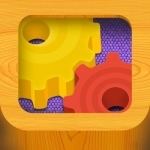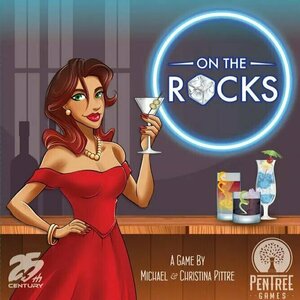Purple Phoenix Games (2266 KP) rated Pirate's Mark in Tabletop Games
Mar 29, 2021
Pirate’s Mark is a bluffing, bidding, press-your-luck card game about finding treasure in the sea and avoiding contracting the Pirate’s Mark: the mark of death. In it players are pirates searching the seas by boasting about how many treasures they expect they will find, flipping over cards, and dealing with any consequences of their pulls. The last pirate to remain unmarked at the end of the game will be the winner and richest of all pirates on the vast seas.
DISCLAIMER: We were provided a copy of this game for the purposes of this review. This is a retail copy of the game, so what you see in these photos is exactly what would be received in your box. I do not intend to cover every single rule included in the rulebook, but will describe the overall game flow and major rule set so that our readers may get a sense of how the game plays. For more in depth rules, you may purchase a copy online or from your FLGS. -T
To setup, include the correct number of cards as described in the rulebook for the number of players. Once the cards are shuffled they will be laid out in a 10 x 15 grid on the table, face-down. The Compass Rose card and die are placed near the card grid and the game is ready to begin!
On a turn a short bidding round commences with players announcing how many cards they believe they can pull from the grid without uncovering a Pirate’s Mark card. This bidding goes around the table with bids increasing with each player until one player calls the bluff and forces the last player to bid to take their turn. That player then pulls a number of cards face-up from the sea and resolves any cards that are immediate, stashes cards that are treasures, and holds cards that contain the phrase, “Play this card,” to be used at a later time.
If the turn is uneventful, by not revealing any Pirate’s Mark cards, then the game continues with bidding and pulling. However, once a pirate reveals a Pirate’s Mark card, they are marked and cannot participate in the bidding any longer (unless they find a way to unmark themselves, which IS possible). Marked players can get back in the game by calling another player’s bluff correctly. There is indeed risk here as a marked player that incorrectly calls a bluff is permanently dead and out of the game.
There are some more rules for the end of the game phase called, “Duel Mode,” but I will let you discover those on your own. Play continues in this fashion until one player is standing and unmarked. This player wins the game and the others need to pack up the 130 cards that were setup. Okay, I added that last part.
Components. This game is a ton of square cards and a fantastic d12 that is only used for the two-player variant. The cards are all glossy, but good quality, and feature photos (akin to screencaps from movies) instead of illustrations. I find the theme to be very present in not only the press-your-luck and bidding/bluffing mechanics, but also in the design of the cards and the photos used. It feels like a piratey game and plays like a piratey game. Like I said, the d12 is fabulous, and I actually happen to own a set of dice that I use for my RPG campaigns… sometimes. All in all the game has some good components and looks great on the table.
So I have some good AND bad news to deliver. First the bad. Some cards that are pulled are way too overpowered. One is called “Blackbeard’s Sword.” It allows the player to “peek under the number of cards left in your bid.” I used this card on a bid of 22 cards and was able to pull all safe cards because this allowed me to see 22 cards and avoid any Pirate’s Marks. Super OP if you ask me. The only other bad I have here is setup. There are 130 cards to be sorted, shuffled, and laid out in a nice-looking grid before the game can be played. For those of us with slight or full-blown OCD that is a nightmare. Luckily, I only stress if the cards are way out of whack instead of just slightly askew.
Now for all the good. I like this game quite a bit. To offset some of the OP of the aforementioned card, the game comes with some pretty great Lucky and Curse cards to be pulled. A couple Lucky cards are, “Drop Anchor,” which ends the player’s turn when revealed, thus negating any Mark pulls, and “Flying Dutchman,” which can be played on a marked player to instantly kill them. Now, I do not condone murder normally, but when playing a pirate game, it is to be expected. The Curses pulled are equally unlucky. “Winds of Fate” allows the person who called the bluff to choose the rest of the cards to be pulled for your turn. OUCH! Especially if they had used “Blackbeard’s Sword” and know where one or more Pirate’s Marks are hidden. Similarly unlucky is “Isla Muerta” which penalizes the player if they have 10 or more treasure cards and pull a Pirate’s Mark – they die instantly from the curse! These are just a few examples of some cards that can be encountered during play, and there are a whole lot more of them included.
I do so enjoy bluffing and luck-based games more and more, and Pirate’s Mark certainly gives it to me on those fronts. Being able to just whisk away 20 or more cards because you happen to have that coveted card you used is devilishly fun. Watching the other players seethe with envy as you pull treasure after treasure and avoid Marks is like winning $20 on a scratch-off. It won’t change your life, but it will give a shot of adrenaline and euphoria for a few minutes. I think Pirate’s Mark fills a void of straight bidding, bluffing, and luck that certainly matches the theme perfectly, and remains a good game as well.
Also, if you happen across one of the expansions, “Parrghty Mode,” it adds another five players to the game and bumps up the count of cards in play from 130 to a whopping 168! This is not for the small of table. I wish there was room inside the base game’s box to fit these extra cards, but alas, there is not.
So if you are like me and enjoy games on the lighter side that perfectly match game to theme, then you have to check out Pirate’s Mark. Purple Phoenix Games gives this one a haunting 8 / 12. I certainly recommend it and will now be finding a place in my main shelf unit for it. Hmm, which game do I make walk the plank…?

Math Sixth Grade - Common Core curriculum builder and lesson designer for teachers and parents
Education and Productivity
App
Are you a teacher, a parent, or an educator of Sixth Grade Math? This is perhaps the only app you...

Remotie: remote for Samsung TV
Utilities and Entertainment
App
Remotie is an elegant and functional remote control with keyboard and touchpad for your Samsung...

Downhill Xtreme
Games and Entertainment
App
JOIN OVER 12 MILLION RACERS AROUND THE WORLD!! Tear past the competition on a fierce ride to the...

Zoosk - #1 Dating App
Dating, Lifestyle and Social Networking
App
With the #1 dating app, 3 million messages sent daily, 8 million verified photos, and 40 million...

Castle Crafter : Survival Craft
Games and Entertainment
App
Get ready for an online epic warfare game in blocks' and cube men's world! It's a live pocket game...

Crazy Gears
Education and Games
App
Are you ready to watch your child kick their learning into high-gear? Crazy Gears is a new-aged...

Eli Explorer
Education and Games
App
***** Winner of ‘Best App Award’ - 2014 European Game Based Learning Competition ***** *****...
Purple Phoenix Games (2266 KP) rated On the Rocks in Tabletop Games
Sep 7, 2021
“On the Rocks is a marble drafting, cocktail recipe fulfillment game for 1-4 players. It is NOT a drinking game.” – straight from the game’s BGG page. So what does that mean? Well, this one is a variation of the “I cut, you choose” style game, but HEAVILY themed around bartending and enhanced with additional fun mechanics. The winner is the player who amasses the most amount of money by the end of their shift.
DISCLAIMER: We were provided a copy of this game for the purposes of this review. This is a retail copy of the game, so what you see in these photos is exactly what would be received in your box. I do not intend to cover every single rule included in the rulebook, but will describe the overall game flow and major rule set so that our readers may get a sense of how the game plays. For more in depth rules, you may purchase a copy online or from your FLGS. -T
To setup, consult the rulebook, as there are many steps. However, once setup, the game should look similar to the photo below. Choose the starting player and the mixology competition can begin!
On the Rocks is played over several rounds with each player completing specific steps. The first step is optional, and is Tip Cards. Players will accumulate Tip Cards throughout the game, and each one features a special ability that may be used at this time. The next step may also be optional, depending on if the active player had received a Complaint card previously. Complaints must be completed on this step and is pretty much a wrench thrown in the plans by competitors.
Once these (possibly) optional steps have been completed the active player then takes the 2d6 and Rolls them. This number determines how many ingredient marbles are to be pulled from the bag and added into play. For the cost of one ingredient marble, the active player may manipulate the rolled dice by flipping it to its opposite face. Next, the player will Draft the number of marbles from the bag they rolled in the previous step. From these drafted marbles the player will Mix them into the blue Jigger Bowls in the middle of the table one at a time, a la Mancala (oh that’s fun to say: A LA MANCALA!). Then the player will Select & Place a jigger of marbles from the table onto their player board. Placing the corresponding marbles onto the drinks is how recipes can be completed. If any ingredients were selected from the jigger but not placed, the player must then place the ingredients into the Extra Ingredients shot glasses on the top portion of the player board, to Save for later use.
When the ingredient marbles have been placed and saved, the player must then complete the Resolve step. Several ingredient marbles are “Premium” or “Spill” marbles. Premium marbles (golden) allow the player to select ANY two ingredients from the draw bag and the Premium marble is then discarded to the coaster in the middle of the table. The black Spill marble forces the active player to draw a Spill card from the deck and complete its action. It also during the Resolve step that the player may complete a recipe card by discarding the drink’s ingredients to the bag and flipping its recipe card face-down. If the entire order (all of the face-up recipe cards) is completed, the active player’s round ends and they notate this by placing one of the three lemon tokens on their player board. Some round end cleanup is performed, like drawing another set of 3 or 4 drink recipes for an order, and the player’s turn is over.
Once a player has completed their third order of drinks, they must indicate “Last Call” to the other players at the table. This informs the other players that they have one last turn to earn any extra money before the game ends. When the game has been finished, final scoring is performed and the winner is they who earned the most money throughout the night. The other players must immediately fix the winner a drink, or buy the winner a shot. Okay, those aren’t in the rulebook, but merely suggestions for the revised second edition…
Components. For those that follow our reviews, you know I am a sucker for games with great components, and this one definitely delivers for me. The aesthetics and art style are just perfect, the double-layer boards are always lovely, and the rubber jiggers are excellent. I cannot see anything that can be improved in terms of components, and I completely expected that because this was published by Pentree Games and 25th Century Games (one of my favorite publishers in the business). The game looks and feels deluxe, which is VERY satisfying.
I think that the Pittre duo of Michael and Christina really knocked it out of the park with this one. Wait, this is their first game design?? And it’s incredible? Okay okay, I’ll be keeping my eye on you two. On the Rocks is a light game with excellent table presence and some difficult choices presented. Now, the choices may be TOOOOOO difficult for some gamers, especially our AP-prone players. Carefully planning out each ingredient’s distribution into the jigger bowls can send them into a frenzy, so I have advised to choose one or two bowls they wish to buff and concentrate on hitting those with the marbles they want, and just randomly place the other ingredients. I know that is a big ask, but this game is supposed to take 45-90 minutes, not 45-90 hours. My other gripe about the game is the color-dependence of the ingredient marbles. I am sorry to all my colorblind friends out there, but I am unable to see how you might keep a possible 12 different marbles straight in your heads while simultaneously remembering the state of marbles in each jigger bowl. I hope I am completely wrong, as I do not suffer from colorblindness, and please do let me know if this is still playable for those gamers.
These gripes aside, everything else about the game is fabulous. I love being able to manipulate my dice rolls (yes, with a cost) to have ultimate control of the number of marbles pulled from the bag. That bag, however, takes control away immediately unless I draft a bunch of clear (wild) or golden marbles to affect my final placements. I also adore struggling to choose which recipes to concentrate on first, and weighing the possibilities of completing the higher value recipes, or blitzing the smaller ones first.
Oh, and the Spills cards? They can be real pains in the booty. These effectively give the active player the ability to completely botch another players’ plans by discarding their ingredient marbles from their player board. Not enough player interaction? How about negative Tip cards, which are earned by completing a recipe, that impede a competitor’s progress by making them complete the Tip card before being able to move on with their plans, or by limiting their marble selection to two instead of the entire bowl? Yeah, this has player interaction for sure.
Again, I like a good drink now and then, just as much as the next person. However, I have never been a bartender, and I do not plan on ever becoming one. I could not ever imagine having to compete with other bartenders for tip money either, especially if it is as brutally cutthroat as On the Rocks portrays it to be. I will, however, play a game where all that “fun” is diluted to dice, cards, and marbles. I was looking through my collection recently and noticed have embarrassingly few games with an adult beverage theme. If you are like me and require more games depicting fun with alcohol, then I strongly urge you to check out On the Rocks. I feel like I can finally graduate from Fuzzy Navels and Stone Sours just by playing this game and really upping my liquor acumen. Purple Phoenix Games gives this one a delicious 5 / 6. It seems readily available for consumption, but please do not try to go drink for drink with this game. It’s not designed to be a drinking game… or is it?
Purple Phoenix Games (2266 KP) rated Aroma in Tabletop Games
Feb 20, 2021
Aroma is a board game that originates from an essential oil company wishing to produce a board game utilizing its oils. Designer Odd Hackwelder then crafted a board game utilizing said essential oils that can be played four different ways. That’s right, Aroma is a game with four different play modes. Most of the modes revolve around the ability to guess the correct scent to score points. For this review I will be referencing rules for the Revolve mode with four players.
DISCLAIMER: We were provided a copy of this game for the purposes of this review. This is a retail copy of the game, so what you see in these photos is exactly what would be received in your box. I do not intend to cover every single rule included in the rulebook, but will describe the overall game flow and major rule set so that our readers may get a sense of how the game plays. For more in depth rules, you may purchase a copy online or from your FLGS. -T
To setup a game of Revolve each player will choose one of the themed player boards and bits from the following: Citrus, Trees, Plants, Floral. They will lay the boards touching in the middle of the table and their oil trays with essential oil bottles in front of them. Each player will also receive the wooden player token and scent tokens in their color. Place the wooden player tokens on the point tracker zero space and the game is setup to begin!
Revolve is played in rounds where each player will choose one of their oil vials from their tray, place its matching scent token face-down on their board and pass it to the player on their left simultaneously. The players then take the vials just given to them, smell the oils inside and try to guess its content scent by choosing the appropriate scent token and placing it face-down on the board in front of them as well. Play continues in this fashion until all players have smelled the vials from all players and made their guesses.
Players then flip over their scent tokens to compare what was given to them throughout the round and they will score points based on how many were guessed correctly. The players then choose a different vial and the process starts anew. The game ends at the end of the fourth round and the player with the most correct guesses is the winner!
Components. This game has pretty amazing components. The oil trays with the little oil bottles are great, but a little flimsy. The boards and scent tokens are thick, and the wooden player pieces are nice and medium-sized. The overall look of the game is very clean and colorful, reminiscent of the art style in T.I.M.E Stories, but with more colors and smells. Aside from the flimsy cardboard used in the oil trays, the rest of the components are top notch. I do have one gripe: the oil bottles themselves sometimes take quite a bit of effort to get the smell going. We tried manually rolling with our fingers, and the suggested technique of rolling on a sheet of paper (we used a paper napkin). The best way was to just drench oneself in essential oil by manually rolling the ball with one’s finger.
As a game Aroma’s Revolve is interesting and invokes feelings not normally used to describe board games. I have not played another game like it, nor one that I can remember using my sense of smell at all. For this point alone I feel attracted to Aroma. However, smelling all the scents over and over can sometimes get a little overwhelming for me. I KNOW what a lemon smells like, but when you pass around a vial and I sniff it, I feel like I am smelling lemon. When the card is revealed and it is actually grapefruit I just smelled I become frustrated. I guess I never realized how closely many things smell to other items in the same family. I like to reminisce about the first time I ever smelled pine, or its unmistakable scent down in my wood shop. But the pine scent in Aroma doesn’t really smell like pine to me. Maybe my snout is aging faster than I thought, but I am really no good at picking out some of these scents.
I have also played the Survive mode with just my wife and of course she always beats me. Survive is the only mode that is designed for two players, and I wish there were more. Getting together during the lockdown is difficult, and I game mostly with my wife. That said, on the rare occasion I got to play games with another couple in our quarantine pod I wanted to break Aroma out and try a different mode. Revolve is good, and Survive is good too, but I would prefer both with the full compliment of players.
If you are looking for something completely different for your collection, Aroma is it. I don’t know if it will make many gamers’ Top 10 lists, but it is so interesting to use the sense of smell in a board game that I think it is almost essential (see what I did there?). I mean that Aroma currently has no competition in the same space, so it will not be replaced by another similar game for quite some time, I’m sure. And what guest wouldn’t be impressed by playing a board game that includes 20 vials of essential oil? How novel is that, anyway? Purple Phoenix Games gives this one a lovely-sniffed 8 / 12. Do be warned: Aroma may accidentally perfume some other games it is stored near, but the scent is pleasant. At least I THINK it is. Now I’m doubting my ability to smell anything correctly.


